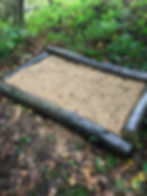How to create the perfect Mushroom Bed
- Johnnie
- Oct 6, 2020
- 2 min read
It's Sunday morning, pouring with rain and I'm knee-deep in sawdust and leaf litter. If someone had told me two years ago I'd be building a mushroom bed, I would've certified them insane. I didn't do gardening back then, never mind understand the mechanics of a mushroom bed. Permaculture was way off my radar.
Maybe by sharing this project others will be inspired to give it a go.
My nephew had given me a pack of 16 pegs/dowels of King Stropharia fungi
Stropharia rugoso that I had been instructed to keep in the fridge until planting day. I'm told they are fairly easy to grow.
So here we go: (I put a 'permaculture hat' on for this project as I was using everything from the wood.)
1). Find a nice shady area; for 16 pegs, an area of 2 square metres is ideal. So I cut some chestnut logs to create a rectangular bed, 2m long x 1m wide

I cleared the brambles and bracken to leave a relatively clear area. This was my base layer.
The sweet chestnut logs had been felled the previous winter and they are very rot resistant; they don't need treating and can be layed straight onto the ground. Old scaffold boards would do, as would treated pine sleepers.
2). Cover the base of the bed with cardboard and soak thoroughly with water. This not only prevents the weeds and brambles from coming through but also provides a moist layer for the mushrooms.

I picked up several boxes from my local supermarket and made sure there were no gaps for the weeds to grown through. The cardboard will eventually mulch down.
3). Next layer to go down was the sawdust. Stropharia need hardwood sawdust and/or wood chip. Don't use pine or any softwoods for this layer - they don't like the sap.

My sawdust had been created a few weeks prior from logging for firewood. One gets a lovely warm feeling when the waste from one job can be used for another.
It took 2 large barrow loads to fill the bed which gave me about a 6" depth of sawdust.
I then levelled the bed making sure there was an even depth.

If you haven't got any sawdust or woodchip, then straw is also a fantastic substrate for this layer. Worth asking your local stables for some.
4). Planting the mushrooms: Taking the bag of Stropharia from the fridge, I pushed them deep down to into the sawdust.

I found it easier to make the holes using a dibber to get down to the cardboard layer.
I then covered over the pegs over with the sawdust.
5). Leaf litter: This layer was easy for me - I had in fact raked up a big area in the woods during August to provide some camping pitches. This was already piled up and again reasonably wet from the recent rain.

Again, I barrowed 2 loads into the bed, raked it over to make it level, then gave it a good soak with the hose, using water from the rainwater harvesting tank.
Water thoroughly for the next two days.
6). All you need to do now is admire your handy work and wait until spring!



